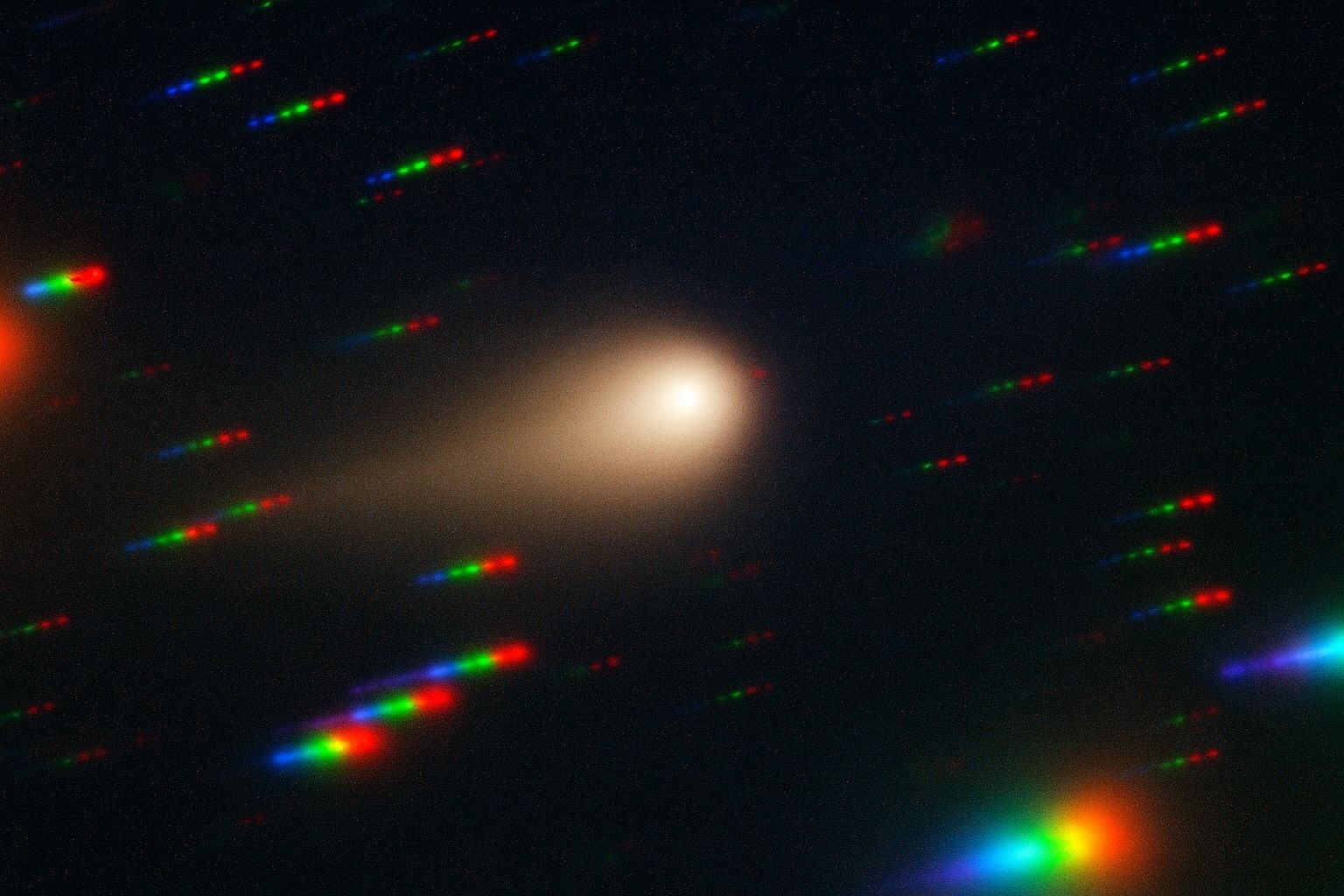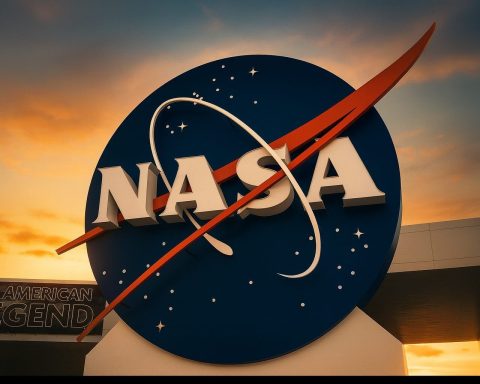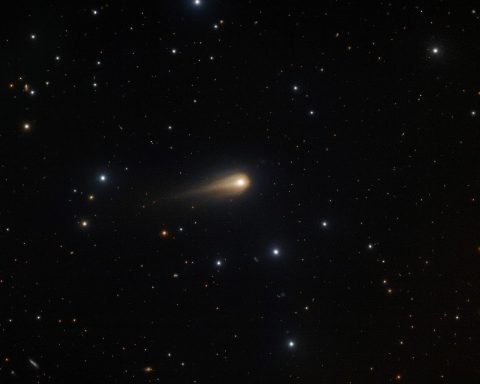- Rare interstellar visitor: Comet 3I/ATLAS – only the third object ever observed coming from beyond our Solar System – was discovered July 1, 2025 by the ATLAS survey. It’s on a one-way hyperbolic trajectory (speed ~58 km/s) and will reach its closest point to the Sun (perihelion) around October 29, 2025, at about 1.4 AU (inside Mars’ orbit) [1]. Fortunately, calculations show it will never approach Earth closer than ~1.8 AU (~270 million km) [2] – no impact threat, according to NASA and ESA.
- Record-breaking comet: Astronomers say 3I/ATLAS is unprecedented in size and speed for an interstellar comet. Hubble observations indicate a solid nucleus up to a few kilometers wide [3], but some data suggest an object 20–46 km across enveloped in dust [4] – potentially the largest and oldest interstellar comet ever seen [5]. It’s extremely active, sporting a visible coma and tail even while still far from the Sun [6]. In late August, telescopes spotted a bizarre “anti-tail” – a jet of gas and dust pointing toward the Sun, opposite a normal comet tail [7] – one of several puzzling features fueling speculation about its true nature.
- Loeb’s alien tech theory: Famed Harvard astronomer Dr. Avi Loeb has publicly raised the possibility that 3I/ATLAS might not be a natural comet at all, but alien technology. He estimates “a 40% chance” the object is some form of spacecraft [8]. Loeb warns that the comet’s upcoming solar flyby is a critical “acid test”: if 3I/ATLAS changes trajectory in an unexpected way after rounding the Sun (something no natural object should do), it would imply intelligent control – a revelation that “could trigger a global stock market crash,” he cautions [9]. “It’s like going on a blind date with a cosmic visitor – we don’t know who or what is in control of this massive technological object,” Loeb told Fox News [10] [11].
- Strange clues spark debate: Loeb and others point to bizarre anomalies in 3I/ATLAS’s properties. Spectrographs detected it venting nickel gas without iron – an odd chemical signature, since on Earth “nickel without iron” only occurs in industrial alloy products [12]. Its coma is also unusually carbon-rich: about 95% carbon dioxide and only 5% water vapor, essentially the opposite of a typical water-rich comet [13]. And unlike prior interstellar visitors, 3I/ATLAS is following a “finely-tuned” path along the plane of our Solar System, even making a close pass by Mars (~30 million km on Oct 3) that Loeb calls “remarkable fine-tuning” [14] [15]. Such precise alignment, he argues, is exactly what an alien probe might do to survey the planets.
- Talk of ‘mini-probes’ and Halloween hype: The mystery object’s timing and behavior have captivated the public – and podcasters. On the Joe Rogan Experience, Loeb speculated that even if 3I/ATLAS doesn’t alter course, it “could still release smaller probes” to quietly visit Earth or Mars as it swings by the Sun [16]. Sensational headlines have dubbed 3I/ATLAS the “Halloween comet,” noting that what Rogan’s guest revealed about it could “keep you up till Halloween night.” The feverish social media buzz – from alien invasion memes to Nostradamus doomsday rumors – shows how 3I/ATLAS has become a viral sensation. Scientists, meanwhile, urge caution and critical thinking amid the hype.
- Experts: likely just a comet, not a threat: The consensus among astronomers and space agencies is that 3I/ATLAS is behaving exactly like a comet from another star – nothing more exotic. “It looks like a comet and it behaves like a comet,” stresses Dr. Michael Küppers of the European Space Agency, noting that no evidence of alien activity has turned up [17]. NASA and ESA emphasize the object’s trajectory is “completely benign” [18] [19] and poses no danger to Earth – instead calling it a rare opportunity to study material from another star system [20]. Researchers have already explained some oddities: for example, the sunward “anti-tail” can be reproduced by natural models of dust grain dynamics under solar heating (CO₂ venting on the sunlit side can make a forward-pointing plume) [21]. The comet’s strange composition – rich in CO₂ and metals – could simply mean it formed in an older, carbon-rich star system unlike ours [22] [23]. In short, extraordinary claims of alien craft require extraordinary evidence, and so far 3I/ATLAS’s quirks have natural explanations.
- Unprecedented observation campaign: 3I/ATLAS has astronomers around the world in a frenzy of observation. In early October, as the comet flew by Mars, two ESA orbiters (Mars Express and ExoMars TGO) managed to photograph it – the first time probes around another planet have imaged an interstellar object [24] [25]. (The comet was extremely faint – “10,000 to 100,000 times fainter than our usual targets,” one scientist noted [26] – appearing only as a small fuzzy dot, but still a historic first.) Here on Earth, major telescopes – from NASA’s Hubble and James Webb to observatories like Keck, Gemini and the VLT – have been tracking 3I/ATLAS for months [27] [28]. Preliminary results show the comet shedding dust at tens of kilograms per second and a nucleus perhaps billions of years old [29]. Upcoming, even spacecraft on other missions will get involved: in November, ESA’s JUICE probe (en route to Jupiter) will turn its instruments toward 3I/ATLAS after perihelion [30], and amazingly, two spacecraft already in space – ESA’s Hera asteroid probe and NASA’s Europa Clipper – are calculated to pass through the comet’s extended tail in the coming weeks, potentially sampling its ions and dust as a bonus experiment [31]. Scientists are seizing this unexpected chance to collect data from an interstellar visitor before it fades away into the darkness of space.
- Waiting for Oct 29 – and watching the markets: The coming days will be decisive in separating science fact from science fiction. As 3I/ATLAS reaches perihelion on Oct 29–30, it will be lost in the Sun’s glare – a cosmic “blind spot” that has everyone from NASA engineers to Wall Street traders on alert [32]. Dr. Loeb calls it a high-stakes moment: if the object emerges from behind the Sun on a wildly different trajectory, that would be a once-in-a-lifetime shock indicating an alien maneuver – with profound implications for humanity and global financial markets [33]. Such a scenario is considered extremely remote by mainstream experts, but not zero. Loeb dubs 3I/ATLAS a potential “black swan event” – low probability but huge consequences [34]. Market analysts note that even unfounded UFO rumors can rattle investors, and an actual confirmation of alien technology would be unprecedented – likely causing a short-term panic selloff (as Loeb warns) followed by long-term impacts on the aerospace and defense sector. For now, however, those are wild hypotheticals. Most scientists expect 3I/ATLAS to behave like a normal comet, perhaps giving us a few more surprises (like bursts of gas or changes in brightness) but ultimately sticking to its calculated course [35]. If that’s the case, the comet will round the Sun harmlessly and begin its long journey back to interstellar space, providing priceless scientific insights but no cosmic drama. And on Earth, after a Halloween full of speculation, both astronomers and stock traders will be able to breathe a sigh of relief.
A Mysterious Interstellar Comet Approaches the Sun
An interstellar mystery object is streaking through our Solar System this week, captivating scientists and skywatchers alike. Officially designated 3I/ATLAS (C/2025 N1), this object is only the third visitor ever confirmed to come from beyond our Solar System [36]. It follows in the footsteps of the cigar-shaped 1I/’Oumuamua (detected in 2017) and comet 2I/Borisov (in 2019) [37]. But 3I/ATLAS is proving to be a unique cosmic guest of its own. Discovered on July 1, 2025 by the ATLAS sky survey telescope in Chile, it immediately stood out by racing in on a steep hyperbolic orbit – meaning it’s not bound to the Sun’s gravity at all [38]. Essentially, 3I/ATLAS is a one-way visitor from deep space: it entered our Solar System from some unknown star and will exit again, never to return [39].
This comet’s speed and trajectory left no doubt about its interstellar origin. It’s barreling sunward at roughly 57–58 km per second – faster than any typical comet bound to the Sun [40]. Its orbital eccentricity is about 6.14, an extreme hyperbola [41]. By tracing its path backward, astronomers confirmed it didn’t originate from any known region of our Solar System like the Oort Cloud [42]. Instead, 3I/ATLAS came from the galactic beyond, making it a “messenger” from another star system. This status has scientists very excited: each interstellar object offers a physical sample of material formed around other stars, billions of years ago – effectively time capsules that can reveal what distant planetary systems are like [43] [44].
Right now, 3I/ATLAS is approaching its big moment: on October 29, 2025, it reaches perihelion, its closest point to the Sun [45]. It will swing inside the orbit of Mars (about 1.36 AU from the Sun, or ~126 million miles away) [46]. Unlike many comets, it’s not diving particularly close to the Sun – it won’t be a “sun-grazer” – but this proximity will warm it enough to trigger maximum activity. After perihelion, the comet will begin heading back out toward deep space, crossing Jupiter’s orbit by March 2026 on its way out of the Solar System [47].
Crucially, Earth is in no danger from this interstellar wanderer. Its path is tilted such that it stays far from our planet. In fact, the closest 3I/ATLAS will ever get to Earth is on November 1, 2025, when it will still be around 1.8 AU away – that’s 170–270 million miles, well beyond even Mars’s orbit [48]. Both NASA and ESA have repeatedly assured the public that 3I/ATLAS poses no threat [49] [50]. “Comet 3I/ATLAS poses no danger to Earth,” NASA confirmed in a recent update, explaining it will remain “far away” during its pass [51]. The European Space Agency likewise highlighted the comet’s benign trajectory – a relief to anyone worried about disaster scenarios.
In other words, 3I/ATLAS is here for scientific intrigue, not menace. As one ESA scientist put it, this alien comet is strictly a spectacle, not a threat [52]. But what a spectacle it is turning out to be – sparking a mix of awe, curiosity, and even a bit of cosmic paranoia as it races by.
Bizarre Features: Why 3I/ATLAS Is Breaking the Rules
While 3I/ATLAS poses no physical danger, it has presented scientists with puzzles almost from day one. Observers quickly noticed that this comet isn’t behaving exactly like the comets we know. It seems to be “breaking all the solar system rules,” as one science outlet put it [53].
One early surprise was its shape and activity. Unlike the enigmatic 1I/’Oumuamua – which was small, tumbling, and had no coma or tail – 3I/ATLAS immediately looked like a comet, with a diffuse coma of gas and dust and a faint tail, even while it was still beyond Jupiter’s orbit [54]. The Hubble Space Telescope snapped images in mid-2025 showing a teardrop-shaped coma and tail, indicating that 3I/ATLAS was already outgassing volatile ice (like CO₂ and H₂O) while it was still very far from the Sun [55]. That was our first hint that 3I/ATLAS is highly active. In fact, by analyzing those images, researchers estimate the comet’s nucleus (solid core) is relatively modest in size – somewhere between roughly 0.5 km and 5.6 km across – yet it was shedding dust at a rate of tens of kilograms per second even at 5+ AU from the Sun [56]. That’s a lot of early activity, suggesting 3I/ATLAS has a volatile-rich composition.
But the dimensions of this object have been a point of debate. Some measurements of its brightness and gas output led to eye-popping estimates that the comet could be much larger than Hubble’s initial size constraint. Data from NASA’s new SPHEREx observatory, for example, suggested 3I/ATLAS might be on the order of 20–46 kilometers wide – an order of magnitude bigger than typical comet cores [57]. (Hubble scientists believe the actual solid nucleus is far smaller, with the larger apparent size due to a surrounding dust cloud reflecting sunlight [58]. So the true size remains uncertain.) If it somehow were tens of kilometers across, 3I/ATLAS would be an absolute giant, possibly the biggest comet nucleus ever observed. Even at a few kilometers wide as currently favored, it’s still a hefty object – much larger than ’Oumuamua was. This is one reason astronomers have mused that 3I/ATLAS could be a “10-billion-year-old time capsule” from another star system [59] – potentially formed before our Sun existed and wandering the galaxy since.
Then there was the strange tail phenomenon. In late August 2025, as 3I/ATLAS traveled roughly 4 AU from the Sun, astronomers using Hawaii’s Keck Observatory and other telescopes noticed something very odd: the comet appeared to have a bright “jet” or spike of material protruding toward the Sun, in addition to the normal tail flowing away from the Sun [60]. Images showed a sunward-pointing plume about 10,000 km long extending from the nucleus [61]. This is essentially an “anti-tail” – a phenomenon where a comet seems to grow a tail in the wrong direction. It looked almost like 3I/ATLAS was shooting a jet of material forward, which is not what comets usually do (normally, solar radiation pressure and the solar wind blow dust and gas tails in the opposite direction from the Sun).
The appearance of this sun-facing spike “set off a frenzy” of interest [62] [63]. To the public imagination, a jet pointing toward the Sun sounded almost like a rocket thruster firing – which inevitably led to speculation: is this thing more than just a comet? Could it be some kind of propelled object? Scientists were intrigued too, but they quickly offered natural explanations. One likely cause of an anti-tail is geometry: at certain viewing angles, the dust in a comet’s orbit can appear projected forward. Moreover, as 3I/ATLAS got closer, the anti-tail didn’t persist – by October it had developed a more conventional tail orientation [64]. Researchers published a model showing that if CO₂ ice jets on the sunlit side blew out a stream of dust grains, the larger grains could linger in the comet’s wake and create the illusion of a forward spike when viewed from Earth [65]. As the comet drew nearer and those grains dissipated, the tail “flipped” back to normal. In short, the sunward jet didn’t require alien tech – just an unusual interplay of comet dust and sunlight. Still, the rarity of such a pronounced anti-tail in an interstellar comet added to 3I/ATLAS’s mystique.
Perhaps the most compelling mystery is the comet’s chemical makeup. Observations by NASA’s James Webb Space Telescope (JWST) in August 2025 revealed that 3I/ATLAS’s coma is extraordinarily rich in carbon dioxide gas [66]. In fact, JWST data showed a CO₂ to H₂O ratio on the order of 8:1 (i.e. it’s emitting about eight times more carbon dioxide than water) [67]. By late October, scientists reported the gas plume was around 95% CO₂ and only 5% H₂O, an almost inverted composition compared to normal comets [68]. Most comets from our Solar System are dominated by water vapor when they become active, with smaller fractions of CO₂, CO, etc. The CO₂-heavy mix suggests 3I/ATLAS formed in a much colder, carbon-rich environment – possibly in the outer regions of a distant protoplanetary disk where water was mostly frozen out, or around an older star with different chemistry [69]. It might even hint that the comet comes from a primordial population of icy bodies that predate our Sun [70].
Additionally, a team using the Very Large Telescope (VLT) in Chile made a puzzling detection: the spectral signature of neutral nickel vapor in the comet’s coma [71]. What raised eyebrows was that they did not detect a corresponding amount of iron vapor. Typically, comets can release heavy elements (interestingly, nickel and iron gases were also detected in Oort Cloud comets and even in ’Oumuamua), but usually nickel and iron appear together in similar proportions. In 3I/ATLAS, it seems nickel is present without its “cosmic twin” iron [72]. Dr. Avi Loeb seized on this, noting that such a combination – lots of nickel and little iron – is “only known to exist in industrially produced nickel alloys” here on Earth [73]. In other words, he argues this could be a technosignature: perhaps the object’s materials aren’t natural. To most comet experts, however, this claim is far-fetched. They acknowledge the nickel finding is weird, but caution that our knowledge of comet chemistry is limited – 3I/ATLAS could have formed around a metal-rich star, or nickel could be outgassing at a different rate than iron. Unusual? Yes. Inexplicable? Not yet. As one astrophysicist put it, “extraordinary claims require extraordinary evidence,” and so far no definitive evidence points to an artificial origin [74] [75].
All these peculiar features – the huge inferred size, the anti-tail, the carbon dioxide dominance, the nickel-without-iron – have certainly challenged scientists’ understanding of comets. 3I/ATLAS is forcing researchers to refine their models of how comets behave and what ingredients they carry, especially those born around other stars [76] [77]. In science terms, this interstellar vagabond is a fantastic outlier that could expand our knowledge of planetary systems. But in the court of public opinion, these oddities have also opened the door for more exotic interpretations – fueling a debate about whether 3I/ATLAS might be “alien” in origin.
Alien Probe or Cosmic Iceball? The Avi Loeb Hypothesis
No one has stoked that debate more than Dr. Avi Loeb. Loeb is a Harvard astrophysicist with a reputation for bold ideas about extraterrestrial intelligence. He made global headlines a few years ago by suggesting that ’Oumuamua – the first interstellar object – might have been an alien light-sail or probe, given its strange shape and unexplained acceleration. Now, with 3I/ATLAS, Loeb is once again at the center of the “alien probe” discussion, backed by some curious data points and a flair for the dramatic.
In public statements over the past week, Dr. Loeb has argued that 3I/ATLAS might actually be artificial – possibly a craft or sentry sent by an advanced civilization. He pegs the odds of this at “around 40%” – surprisingly high [78]. While most of his colleagues would give near-zero odds to that scenario, Loeb insists we must follow the evidence and “not dismiss the possibility of an extraterrestrial origin” out of hand. The evidence he cites includes the anomalies mentioned earlier: the object’s extreme size/reflectivity, its unusual composition (nickel and CO₂), and its oddly perfect orbital alignment with the Solar System’s plane [79].
Unlike natural comets that come in at random angles, 3I/ATLAS’s path lies almost flush with the ecliptic plane (where the planets orbit) [80]. Loeb finds this very suspicious: if an alien intelligence wanted to observe the Solar System’s inner planets, sending a probe along the ecliptic would be an ideal choice, giving close passes to multiple planets at once [81]. Indeed, on October 3, 2025, 3I/ATLAS did something intriguing – it passed within ~29 million km of Mars, effectively a close flyby of the Red Planet [82]. Loeb calls this a “remarkable fine-tuning” of the trajectory [83]. To him, it’s as if the object deliberately “used Mars as a pit stop” or observation point. During that encounter, NASA’s Mars Reconnaissance Orbiter snapped photos with its HiRISE telescope (though the comet was just a speck in those images) [84]. Loeb has even suggested that we scour those Mars flyby observations for any signs of “precursor objects” – essentially, smaller craft that might have separated from the main body to explore Mars or its moons [85].
This leads to Loeb’s next provocative idea: could 3I/ATLAS be releasing “mini-probes”? On an October episode of Joe Rogan’s podcast, Loeb speculated that as the object nears the Sun, it might deploy small probes (perhaps high-tech nano-craft) to visit Earth, Mars, or other targets [86]. In his scenario, 3I/ATLAS could be a “mothership” of sorts – maybe an alien surveillance platform – and the timing of its perihelion (late October) is when it would drop off its investigative devices, using the Sun’s gravity as a slingshot. This idea sounds straight out of science fiction, and mainstream scientists largely roll their eyes at it. But Loeb’s stature means his words carry weight in media. His Joe Rogan interview went viral, and headlines around the world picked up the sensational quotes about “mini-probes” potentially “invading” Earth. As an Instagram post by the International Business Times summed it up: Astrophysicist Avi Loeb breaks down why he claims the 3I/ATLAS comet could release “mini probes” meant to “invade” Earth [87].
Loeb’s most dire warning, however, came during an interview with Fox News and in an op-ed he circulated. He warned that humanity was effectively on a “blind date with a cosmic visitor” whose intentions are unknown [88]. The real moment of truth, he said, would occur around October 30, 2025, just after perihelion. Why then? Because during the days around October 29–30, 3I/ATLAS will be almost directly behind the Sun from Earth’s perspective, making observations difficult or impossible. Loeb likened this to going behind a curtain – we won’t see what it’s doing for a short time [89]. If the object were some controlled craft, that would be the perfect time for it to alter its course or do something unexpected, hidden from our telescopes. The Harvard professor then dropped a bombshell: if 3I/ATLAS “appears on a different path” after emerging from behind the Sun, it would indicate an intelligent maneuver – and in that case, he said, “the stock market may crash” [90]. The reasoning is that such a revelation (essentially confirmation of alien technology in our solar system) would spark global fear and uncertainty, at least initially, rattling economies. Loeb called this a potential “black swan event that we haven’t anticipated”, warning that even if the probability is low, “the consequences would be huge” [91].
This dramatic statement grabbed the attention of not just scientists but also financial analysts and government agencies. It’s not often that an astrophysicist talks about a comet possibly crashing the stock market. Loeb’s scenario assumes an extreme outcome – essentially, that 3I/ATLAS proves to be under alien control. How likely is that? Almost every expert would say exceedingly unlikely. NASA’s official stance is that there is “no indication whatsoever” that 3I/ATLAS is anything but a natural comet, and they expect it to follow the trajectory physics predicts [92]. Indeed, as 3I/ATLAS approached the Sun, astronomers saw no suspicious deviations. Unlike ’Oumuamua, which had a tiny non-gravitational acceleration (likely from outgassing) that some found mysterious, 3I/ATLAS so far appears to be moving exactly as a comet should under gravity. No sudden speed changes, no zig-zags.
Loeb acknowledges that his theory is a long shot – he frames it as exploring a possibility that others ignore. His Galileo Project, a privately funded research initiative, is actually designed to look for evidence of extraterrestrial technologies, from UFOs in Earth’s atmosphere to interstellar objects like this. In the case of 3I/ATLAS, Loeb’s team has been urging colleagues to watch closely for any anomalies at perihelion. If nothing else, he says, we should be prepared to rapidly investigate should 3I/ATLAS do something truly unexpected. And if it indeed behaves like an ordinary comet? Then that’s the outcome he expects if it’s natural. Loeb’s point is that only data can rule the idea out definitively. In his words, “only evidence can reveal its true origin,” so we must look closely [93].
For now, Loeb’s musings have been met with a mix of fascination and skepticism in the scientific community. Many astronomers are uncomfortable with how much media attention the alien theory is getting, fearing it distracts from the very real scientific value of 3I/ATLAS. Others counter that Loeb is doing what science should do – considering all hypotheses, even unconventional ones, until we have the data. The coming days will be telling: either 3I/ATLAS behaves mundanely and the alien idea fades, or it does something to keep the debate alive.
Science Teams vs. Speculation: “Extraordinary Claims Require Extraordinary Evidence”
Amid the whirlwind of speculation, mainstream scientists have doubled down on a simple message: 3I/ATLAS shows no signs of alien technology, and people shouldn’t leap to wild conclusions when more plausible natural explanations exist. NASA, ESA, and professional astronomers worldwide have been busy debunking the rumors and highlighting what we do know about this comet.
Firstly, experts remind us that we’ve seen strange comets before – even in our own solar backyard. Comets can have odd compositions (for instance, some Oort Cloud comets also showed unexpected gases like nickel and even molecular oxygen). They can exhibit anti-tails under certain conditions, as 3I/ATLAS did. They can even appear to accelerate slightly due to jets of gas (which was the likely case for ’Oumuamua’s puzzling acceleration). None of these require alien intervention. As Dr. Michael Küppers (ESA’s comet expert) emphasized, 3I/ATLAS “looks like a comet and it behaves like a comet” – there’s nothing that definitively breaks the mold [94]. It has a coma and tail, it brightens and dims consistent with outgassing activity, and its orbit – while hyperbolic – matches what we’d expect for an interstellar object following the laws of gravity. If it were under intelligent control, one might expect some irregular course changes or signal emissions; none have been detected. No unusual radio signals or communications have been picked up from 3I/ATLAS either, according to listening campaigns (similar to how astronomers checked ’Oumuamua for radio transmissions and found nothing) [95] [96].
NASA and ESA have also tried to calm the public with facts. NASA officials have repeatedly stated that aside from its interstellar origin, 3I/ATLAS’s features “are fully consistent with a comet” and that it offers a “rare opportunity to study” material from another star, not an impending apocalypse [97]. Both agencies took the unusual step of issuing press releases to knock down some of the wilder claims circulating online. For example, a falsely attributed quote had been trending on social media claiming physicist Michio Kaku said 3I/ATLAS was definitely an alien ship. In reality, Kaku made no such statement – it was a hoax that got traction [98]. (Kaku did comment more cautiously that an “energy boost” near the Sun could reveal if it’s artificial [99], but he didn’t assert it is a spaceship.) NASA clarified that early weirdness like the comet’s faint glow or outgassing was likely due to natural ices being heated, not any sci-fi engines [100].
On the specific anomalies Loeb cites, many scientists have offered down-to-earth explanations:
- The nickel-without-iron issue: Some comet researchers suggest that if 3I/ATLAS formed in an environment with slightly different chemistry, or if iron is bound in dust grains while nickel comes off as gas at lower temperatures, you could get the observed imbalance. It’s unusual, yes, but not implausible naturally – we simply haven’t studied enough interstellar objects to know what’s typical.
- The CO₂-heavy composition: This actually fits the narrative of 3I/ATLAS being from a very cold, distant region. CO₂ (carbon dioxide) ice sublimates at a lower temperature than water ice. If this comet spent most of its life in the frigid outskirts of some star system (or in interstellar space), much of its water could have been locked up, while CO₂ was more abundant or now releases more easily. As one NASA scientist said, “That gives us a window into conditions in another solar system” – it’s scientifically exciting, but “no alien technology needed” to explain it [101].
- The orbit alignment: While 3I/ATLAS’s path is indeed flatter relative to the ecliptic than ’Oumuamua’s was, it might just be chance. With a sample size of three interstellar objects, we can’t draw firm conclusions. Borisov, for instance, came in at a very different angle. There could be observational biases too (it might be easier to discover interstellar objects that enter near the plane of the planets). Astronomers at the Minor Planet Center note that 3I/ATLAS’s orbit isn’t perfectly aligned – it’s off by a few degrees – which might argue against a deliberate flight plan. And while the Mars flyby is interesting, 30 million kilometers is still a pretty distant miss in space terms (Mars wasn’t “visited” in any meaningful sense; our Mars orbiters struggled just to get a speck of it on camera) [102] [103]. If an intelligent probe wanted a close look at Mars, one might expect it to actually aim for the planet or its moons, not whiz past at such a large distance.
In sum, the prevailing view is that 3I/ATLAS’s strange qualities are likely natural – products of an exotic birthplace and 10 billion years drifting through the galaxy, not of E.T. tweaking the controls. But scientists are thrilled about those strange qualities, because they challenge our models. “This object is making us rethink comet physics,” said one researcher, referencing the anti-tail and the grain-sublimation model that explained it [104]. Every piece of data we gather on 3I/ATLAS will enrich our understanding of how comets form around other stars and what ingredients they carry. In effect, nature has delivered a pristine fragment of an alien solar system to our doorstep, and that’s priceless for science.
Eyes on the Skies: Historic Observations and What’s Next
While the debate rages, astronomers aren’t just pontificating – they’re actively observing 3I/ATLAS with every tool available, making this one of the most intensely studied comets in history. The interstellar interloper has spurred a truly global (and even interplanetary) campaign to collect data.
Back in early October, 3I/ATLAS provided a special opportunity when its trajectory brought it relatively near Mars. On October 3, at about 30 million kilometers from Mars, the comet was close enough (in cosmic terms) for spacecraft orbiting Mars to attempt observations [105] [106]. The European Space Agency’s Mars Express and the ExoMars Trace Gas Orbiter turned their cameras toward the faint object between October 1–7 [107]. Capturing an interstellar comet from Mars’s neighborhood was a real challenge – the target was “10,000 to 100,000 times fainter than our usual targets,” according to Dr. Nick Thomas, the camera lead on ExoMars [108]. Indeed, the images returned showed only a tiny fuzzy dot against the void [109]. Yet, it was a landmark achievement: the first close-range images of an interstellar comet. These Mars-based observations are now being analyzed to estimate the comet’s brightness and composition from a different vantage point. NASA’s Mars Reconnaissance Orbiter also tried to image 3I/ATLAS with its powerful HiRISE telescope. However, the U.S. government shutdown in early October delayed the processing and release of those images [110], which unfortunately fueled some conspiracy chatter online (“What are they hiding?” some wondered). Once the data is out, scientists hope to compare the Mars-side view with Earth-based observations for a fuller picture.
Here on Earth, telescopes have been tracking 3I/ATLAS since its discovery. The Hubble Space Telescope took early images and constrained the nucleus size [111]. JWST provided detailed infrared spectra in August, confirming the CO₂-rich composition [112]. Ground-based observatories – Hawaii’s Keck, Chile’s Very Large Telescope (VLT), the Gemini North and South telescopes, and many others – have been monitoring the comet nightly as it brightens on approach to the Sun [113] [114]. Amateur astronomers with good equipment have also joined the effort, though 3I/ATLAS remains too faint for backyard telescopes at the moment (it’s never expected to become visible to the naked eye; at best it might appear as a dim smudge in medium-sized telescopes by December) [115].
Space agencies have marshaled their resources too. NASA scheduled observations with SOFIA (the airborne infrared observatory) and even looked for chances with the Parker Solar Probe (though Parker’s focus is the Sun, it might detect dust from the comet if it passes through). ESA, for its part, has arranged for the JUICE spacecraft (currently en route to Jupiter) to point its cameras and spectrometers toward 3I/ATLAS in mid-November, after the comet’s perihelion, to see how the close solar pass affected it [116]. But one of the most remarkable aspects of this campaign is the accidental fly-throughs that will occur: Mission planners realized that the long tail of 3I/ATLAS, which could stretch for millions of kilometers, might sweep across the paths of two spacecraft that are already cruising through the inner Solar System. ESA’s Hera probe (launched to visit a binary asteroid in a few years) and NASA’s Europa Clipper (headed to Jupiter’s moon Europa) will pass through the comet’s tail in late October and early November [117]. They won’t see the comet’s nucleus, but their particle instruments could directly sample dust or ionized gas from 3I/ATLAS’s tail – effectively letting us touch the contents of an interstellar comet for the first time. Scientists are eagerly anticipating those readings, which could reveal the comet’s composition in situ and test if its material is truly unusual or just like that of known comets [118].
As the comet rounds the Sun on Oct 29–30, there will be a brief observation blackout due to solar glare. This is the nail-biting period that Loeb and others have dramatized as the potential “moment of truth.” But astronomers are more calmly using it as a time to reposition their instruments. Right after perihelion, when 3I/ATLAS emerges from behind the Sun, telescopes will be trained on it to see if the intense solar heating caused any fragmentation or outburst. It’s not uncommon for comets to break apart or erupt in bright jets after perihelion, so that’s a real possibility (and a natural one) to watch for. Additionally, researchers will carefully analyze the comet’s post-perihelion trajectory to check for “non-gravitational accelerations” – slight deviations caused by asymmetric outgassing (or, hypothetically, other forces) [119]. If 3I/ATLAS shows a small push (like ’Oumuamua did), scientists will try to attribute it to venting of gas. If it doesn’t, that’s actually more consistent with a normal comet (Borisov, the last interstellar comet, followed purely ballistic motion to the precision of measurements).
In essence, the next few weeks are a scientific sprint to gather as much data on 3I/ATLAS as possible before it recedes into the outer Solar System, not to return. By early 2026, the comet will dim beyond detectability for most instruments. But the treasure trove of observations collected now will keep astronomers busy for years. Laboratories will analyze the spectra to deduce the comet’s precise chemical makeup (how much formaldehyde? any complex organics? what isotopes of oxygen and carbon?). Dynamicists will study its orbit for any subtle perturbations that might hint at forces like solar radiation pressure or jets. And comparative planetologists will stack 3I/ATLAS’s properties against Oumuamua and Borisov to start sketching an idea of what interstellar objects are like on the whole. With only three known, every data point counts.
One could say we’re witnessing history: humanity’s first detailed encounter with a sizable interstellar comet. It’s happening almost in real-time, with webcasts of telescope imagery and rapid-fire preprint papers being shared among the scientific community. This is why, despite the distraction of alien theories, most scientists are thrilled by 3I/ATLAS for what it definitively is: a chunk of another solar system, here in our skies.
The Broader Impact: Public Fascination and Market Jitters
3I/ATLAS hasn’t just been a scientific curiosity; it’s also become a bit of a cultural phenomenon, especially given its approach coincides with Halloween season. The idea of an “alien” comet arriving on All Hallows’ Eve has proven irresistible to headlines. Around the world, news outlets have run eye-grabbing stories: “What will happen on Oct 29? 3I/ATLAS could reveal its true identity” and “Joe Rogan’s guest says 3I/ATLAS could be watching us” are just a couple of examples from this week’s news cycle. A series of sensational reports (some in reputable publications, others in tabloids) have conflated expert analysis with speculative fiction, contributing to a frenzy of clicks and shares.
On social media, 3I/ATLAS memes and conspiracy theories abound. Some YouTubers and TikTokers have dubbed it the “Halloween Visitor” or “Atlas Alien.” Wild claims – from it causing earthquakes, to it being a predicted “sign” from Nostradamus – have trended on Twitter (X) and Reddit, illustrating how an astronomical event can morph into a modern folklore story overnight. The International Business Times (UK) even ran a piece compiling the various fringe theories: everyone from Nostradamus and Baba Vanga adherents to UFO hunters had something to say about 3I/ATLAS’s ominous significance [120].
This all puts scientists in an interesting spot: they want to engage the public’s fascination but also have to temper the fear and misinformation. Many astronomers have taken to social media themselves to answer questions and debunk false rumors. In a way, 3I/ATLAS has become a case study in science communication. The public clearly has a huge appetite for the mystery and wonder of an interstellar visitor – and yes, for the thrill of imagining alien contact. As Dr. Loeb himself noted, the subject “captures the imagination because it touches on Are we alone?, one of the biggest questions we have.” That said, responsible scientists emphasize the need for evidence. As one put it, “Extraordinary claims require extraordinary evidence – and so far, 3I/ATLAS hasn’t provided it”. In fact, the most extraordinary thing 3I/ATLAS has provided is a wealth of scientific data, not little green men.
What about the economic angle? It’s not every day that talk of an interstellar comet reaches the halls of finance, but Loeb’s stock market warning certainly got attention. On financial news forums, a few traders half-jokingly discussed hedging their portfolios “in case the alien ship shows up.” The consensus in serious circles, however, is that the likelihood of any market-moving event from 3I/ATLAS is negligible. Market analysts point out that investor sentiment is driven by earnings, interest rates, geopolitical events – not comets. Unless some shocking revelation occurs (like a clear sign of extraterrestrial tech), markets are expected to tune out the noise. “If we actually found alien technology, all bets are off for a few days,” one Wall Street strategist commented, “but if it’s just a weird rock, it’s a non-event financially.”
Interestingly, some have speculated that if alien tech were confirmed, certain sectors could see a boost – for instance, shares of defense contractors or aerospace companies might rise on expectations of new government focus (think space security, communication, exploration initiatives). Companies in the space industry (like rocket manufacturers, satellite firms, even speculative “space mining” startups) could draw investor interest on the thesis that an alien encounter would massively accelerate space investment. On the flip side, airlines, travel, and general consumer stocks might dip initially due to public shock or panic. This is the kind of scenario Loeb implied: a short-term panic sell-off (“crash”) followed by reallocation toward space and tech assets once the dust settled. It’s all very hypothetical – essentially a thought experiment merging astronomy with economics.
As of now, though, markets have not reacted in any measurable way to 3I/ATLAS. The comet’s drama remains largely an internet and scientific community affair. If you didn’t know to look for it, the financial world is business-as-usual. Still, the fact that a cosmic event even entered the market conversation is noteworthy. It shows how an event that captures public imagination (even if remote) can become a “risk factor,” however remote, that people chatter about. In an age of meme stocks and social media-driven sentiment, perhaps it’s unsurprising that an alien comet theory could, fleetingly, become part of the narrative.
Conclusion: Awaiting the Cosmic Reveal
As October 29 approaches, scientists and enthusiasts alike are waiting with a mix of excitement and caution. Will 3I/ATLAS confirm our scientific expectations – or defy them? The smart money is on the former: that this interstellar comet will round the Sun behaving like comets do, offering no “E.T. phone home” moments. In all probability, by early November we’ll have a comet continuing on its outbound path, a trove of new data about an ancient visitor, and a lot of debunked hype.
Yet, the allure of the unknown is powerful. Even seasoned astronomers admit a tiny thrill at the question “what if?” What if by Halloween we detect something truly anomalous – say, an unexpected course change, or a signal, or some configuration that natural processes can’t explain? The odds are extremely low, but the impact would be immeasurable. It’s the kind of event that would indeed make history (and yes, maybe jolt markets and society at large). For better or worse, 3I/ATLAS has reminded the world that science can surprise us and that the boundary between knowledge and speculation is where much curiosity lives.
In the meantime, the best course is to follow the evidence. Over the next few days, telescopes will gather that evidence, and scientists will analyze it rigorously. By the first week of November, we should know whether 3I/ATLAS did anything unusual as it slingshot past the Sun. If it did, the story will escalate in ways we can barely predict. If it didn’t (which is far likelier), the “alien probe” narrative will fade into a fascinating footnote, and 3I/ATLAS will be celebrated as a scientific marvel rather than a harbinger of extraterrestrials.
Either way, one thing is certain: 3I/ATLAS has already made its mark. It has given humanity a cosmic spectacle right in time for the Halloween season, sparked global conversations about life in the universe, and pushed the boundaries of our scientific observation capabilities. From a sleepy discovery in July to a media sensation in October, this little interstellar comet has shown us how quickly the extraordinary becomes part of our everyday discourse.
As we await the final chapters of this visitor’s journey through our Solar System, we can appreciate the moment for what it is – a chance to witness history in the making. Whether 3I/ATLAS turns out to be alien technology (almost certainly not), a quirky natural comet (almost certainly yes), or something in between, we are witnessing an incredible intersection of science, imagination, and society. And that’s a story worthy of the stars.
Sources:
- ATLAS discovery data & NASA/ESA statements on 3I/ATLAS’s trajectory and safety [121] [122]; Live Science via TS2 on comet’s record-breaking size/velocity [123].
- Times of India Science Desk – explanation of 3I/ATLAS’s anti-tail and dust dynamics [124]; JWST findings on CO₂ and composition [125].
- Dr. Avi Loeb’s comments: Fox News interview (via IBTimes) on potential course change and stock market impact [126]; Joe Rogan podcast remarks on “mini probes” and Oct 29 “reveal” [127]; Loeb’s anomaly list (nickel vs. iron, CO₂ 95%, ecliptic trajectory) [128] [129]; Loeb’s 40% estimate of alien tech chance (Economic Times) [130].
- ESA/M. Küppers quote (“looks like a comet…”) and scientist reactions debunking alien claims [131]; NASA confirmation of no threat [132].
- Observation campaign highlights: Mars orbiter imaging attempt (ESA release) [133]; upcoming JUICE, Hera, Clipper interactions [134]; Hubble and ground telescope findings (TS2 Tech) [135] [136].
- Media & market buzz: IBTimes UK coverage of Loeb’s theories and public reactions [137] [138]; WION News headlines (Oct 2025) on Rogan guest claims; Finance commentary on speculative “black swan” scenario [139].
- (TechStock² / TS2.tech) In-depth analysis of Comet 3I/ATLAS’s behavior and scientific significance [140] [141], providing context to separate facts from fiction in this interstellar encounter.
References
1. ts2.tech, 2. ts2.tech, 3. ts2.tech, 4. www.ibtimes.co.uk, 5. ts2.tech, 6. ts2.tech, 7. ts2.tech, 8. economictimes.indiatimes.com, 9. www.ibtimes.co.uk, 10. www.ibtimes.co.uk, 11. www.ibtimes.co.uk, 12. www.ibtimes.co.uk, 13. www.ibtimes.co.uk, 14. www.ibtimes.co.uk, 15. www.ibtimes.co.uk, 16. www.ibtimes.co.uk, 17. ts2.tech, 18. ts2.tech, 19. ts2.tech, 20. ts2.tech, 21. timesofindia.indiatimes.com, 22. ts2.tech, 23. timesofindia.indiatimes.com, 24. ts2.tech, 25. ts2.tech, 26. ts2.tech, 27. ts2.tech, 28. ts2.tech, 29. ts2.tech, 30. ts2.tech, 31. ts2.tech, 32. www.ibtimes.co.uk, 33. www.ibtimes.co.uk, 34. www.ibtimes.co.uk, 35. ts2.tech, 36. ts2.tech, 37. ts2.tech, 38. ts2.tech, 39. ts2.tech, 40. ts2.tech, 41. ts2.tech, 42. ts2.tech, 43. ts2.tech, 44. ts2.tech, 45. ts2.tech, 46. ts2.tech, 47. ts2.tech, 48. ts2.tech, 49. ts2.tech, 50. ts2.tech, 51. ts2.tech, 52. ts2.tech, 53. timesofindia.indiatimes.com, 54. ts2.tech, 55. ts2.tech, 56. ts2.tech, 57. www.ibtimes.co.uk, 58. www.ibtimes.co.uk, 59. ts2.tech, 60. ts2.tech, 61. ts2.tech, 62. ts2.tech, 63. ts2.tech, 64. timesofindia.indiatimes.com, 65. timesofindia.indiatimes.com, 66. ts2.tech, 67. ts2.tech, 68. www.ibtimes.co.uk, 69. ts2.tech, 70. ts2.tech, 71. www.ibtimes.co.uk, 72. www.ibtimes.co.uk, 73. www.ibtimes.co.uk, 74. timesofindia.indiatimes.com, 75. timesofindia.indiatimes.com, 76. timesofindia.indiatimes.com, 77. timesofindia.indiatimes.com, 78. economictimes.indiatimes.com, 79. www.ibtimes.co.uk, 80. www.ibtimes.co.uk, 81. www.ibtimes.co.uk, 82. www.ibtimes.co.uk, 83. www.ibtimes.co.uk, 84. ts2.tech, 85. www.ibtimes.co.uk, 86. www.ibtimes.co.uk, 87. www.instagram.com, 88. www.ibtimes.co.uk, 89. www.ibtimes.co.uk, 90. www.ibtimes.co.uk, 91. www.ibtimes.co.uk, 92. ts2.tech, 93. www.ibtimes.co.uk, 94. ts2.tech, 95. ts2.tech, 96. ts2.tech, 97. ts2.tech, 98. ts2.tech, 99. www.ibtimes.co.uk, 100. ts2.tech, 101. ts2.tech, 102. ts2.tech, 103. www.ibtimes.co.uk, 104. timesofindia.indiatimes.com, 105. ts2.tech, 106. ts2.tech, 107. ts2.tech, 108. ts2.tech, 109. ts2.tech, 110. ts2.tech, 111. ts2.tech, 112. ts2.tech, 113. ts2.tech, 114. ts2.tech, 115. ts2.tech, 116. ts2.tech, 117. ts2.tech, 118. ts2.tech, 119. timesofindia.indiatimes.com, 120. www.ibtimes.co.uk, 121. ts2.tech, 122. ts2.tech, 123. ts2.tech, 124. timesofindia.indiatimes.com, 125. ts2.tech, 126. www.ibtimes.co.uk, 127. www.ibtimes.co.uk, 128. www.ibtimes.co.uk, 129. www.ibtimes.co.uk, 130. economictimes.indiatimes.com, 131. ts2.tech, 132. ts2.tech, 133. ts2.tech, 134. ts2.tech, 135. ts2.tech, 136. ts2.tech, 137. www.ibtimes.co.uk, 138. www.ibtimes.co.uk, 139. www.ibtimes.co.uk, 140. ts2.tech, 141. ts2.tech










